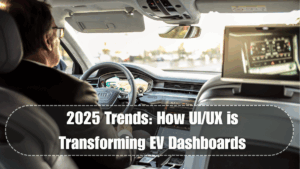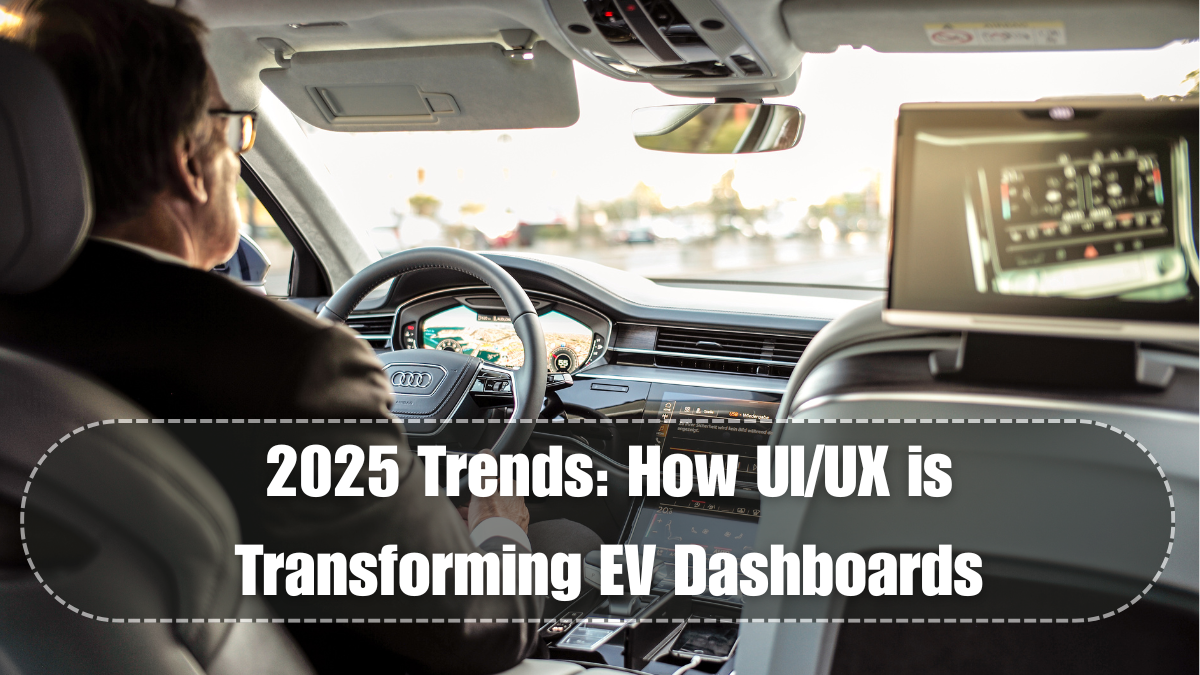As the electric vehicle (EV) revolution continues, automotive UI design trends 2025 are bringing about a complete transformation in how drivers engage with in-car technology. From sleek digital dashboards to voice-controlled displays and AI-enhanced assistance, the modern EV interface is moving far beyond buttons and knobs.
Automakers are now reimagining vehicle interiors as intelligent digital environments, where safety, functionality, and aesthetics blend seamlessly. The focus is shifting to automotive UX that prioritizes intuitive interaction, minimalism, and real-time customization. For consumers in 2025, the car is no longer just a mode of transport—it’s an extension of their digital lifestyle.
Let’s explore the top car UI trends that are setting new standards in the EV and self-driving car space across the globe.

Minimalist dashboards with voice and gesture control
One of the biggest automotive UI design trends 2025 is the shift toward minimalism. EV manufacturers are eliminating cluttered dashboards and replacing them with smooth touchscreens, voice interfaces, and gesture-based controls. This not only enhances the aesthetic appeal but also reduces driver distraction by offering easier access to essential functions.
Many leading EV brands are integrating voice-activated systems powered by AI, allowing users to control music, navigation, climate, and even car diagnostics without taking their hands off the wheel. In addition, EV interface systems with gesture recognition are now being tested in premium models to allow for contactless interaction—a key highlight in post-pandemic design considerations.
Hyper-personalization via AI and cloud-based profiles
As vehicles become more connected, personalization has become a key pillar of automotive UX. In 2025, EV dashboards are using AI to remember user preferences—seat positions, mirror angles, favorite routes, media choices—and sync them across multiple vehicles owned by the same person via the cloud.
This level of personalization allows each journey to feel seamless and tailored. Moreover, automotive UI design trends 2025 reflect this by offering dashboard themes, color palettes, widget arrangements, and notification preferences that can be altered on the go. What was once considered a luxury is now becoming standard across EV models.
Real-time navigation and driver assistance overlays
The integration of AR (Augmented Reality) into EV interfaces is no longer futuristic. Many car brands are embedding real-time data overlays within the dashboard or HUD (Heads-Up Display), which highlight turn-by-turn navigation, nearby charging stations, traffic alerts, and even hazard warnings without requiring drivers to look away from the road.
These overlays enhance car UI trends by reducing the cognitive load on drivers. For example, in urban traffic zones, the system can dynamically reroute the vehicle using live data, display obstacle alerts, or show lane-change suggestions, contributing to a more intuitive automotive UX.
Sustainability meets screen innovation
With EVs being synonymous with sustainability, automotive UI design trends 2025 are also becoming eco-conscious. Dashboard materials now often include recycled composites, while the display screens themselves are more energy-efficient. Some manufacturers are even experimenting with e-ink displays for specific functions like range tracking or speedometers.
Additionally, split-screen displays now allow different passengers to view distinct content—navigation for the driver, entertainment for the front passenger, and rear-seat screens for streaming content. This multi-display EV interface innovation is set to enhance comfort, privacy, and functionality.
Key 2025 UI/UX dashboard features in EVs
| Feature | Purpose | Integration Level |
|---|---|---|
| Voice Command Integration | Hands-free control of all car functions | High |
| AR-Based Navigation Overlays | Enhanced road visibility and safety | Growing |
| Customizable Digital Themes | Personal branding inside the vehicle | Common |
| Gesture Recognition | Touchless interaction | Emerging |
| Driver Biometrics | Security and personalized settings access | Advanced Models |
| Split-Screen Display for Passengers | Multi-function dashboard layout | Mid to High-End |
These dashboard innovations represent a convergence of tech, design, and ergonomics. All are defining elements in the latest automotive UI design trends 2025.
Car manufacturers leading the UI revolution
The global EV market is currently being shaped by automakers who understand the role of strong automotive UX. Companies like Tesla, Rivian, BMW, Hyundai, and Tata Motors are heavily investing in HMI (Human-Machine Interface) design teams to experiment with new ways of delivering real-time data, driver control, and safety.
Tata Motors, for example, has launched EV models with regionally adaptive dashboards that offer multilingual voice commands and UI layouts based on regional driving conditions. Similarly, BMW’s iDrive system and Tesla’s full-screen central UI have set benchmarks in EV interface design that others are rapidly catching up with.
FAQs
What are the key automotive UI design trends 2025?
Top trends include minimalist dashboards, voice & gesture control, AI-based personalization, AR navigation overlays, and eco-friendly display setups.
How is UX different in EVs compared to traditional cars?
Automotive UX in EVs is more integrated with digital ecosystems. It offers real-time updates, intelligent settings, and smart navigation options.
Are these UI features available in mid-range EVs?
Yes, many features like voice control, digital dashboards, and personalized settings are now standard in mid-range EVs, reflecting mass adoption of car UI trends.
What role does AI play in EV interfaces?
AI customizes the driving experience by learning driver behavior, adjusting dashboard layouts, and providing predictive assistance.
Is safety affected by touchscreen-focused dashboards?
Touchscreens are now designed with safety protocols. Many EV interface designs feature large icons, simplified menus, and voice overrides to ensure safe usage.
Conclusion
The wave of automotive UI design trends 2025 is radically reshaping how drivers and passengers experience the inside of a vehicle. The modern automotive UX is no longer an add-on—it’s a core part of the car’s identity. With every swipe, tap, or voice command, today’s EV dashboards are setting new standards in safety, sustainability, and personalization. As car UI trends continue evolving, drivers can look forward to vehicles that don’t just move—but understand, assist, and adapt to them in real time.
Click here to know more.
